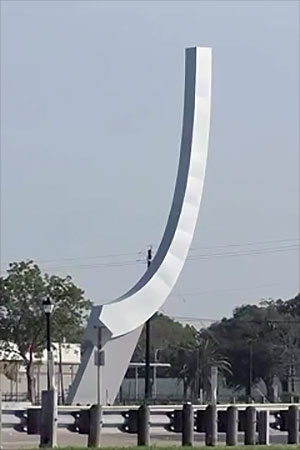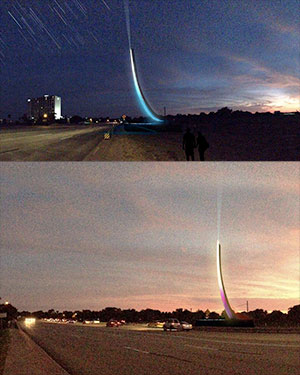July 17, 2020 — A Houston suburb is celebrating its 50-year connection to NASA with a monument designed to serve as a beacon for continued space exploration.
The City of Nassau Bay, Texas, held a brief ceremony on Thursday (July 16) to dedicate the towering outdoor art installation, which stands at the corner of NASA Road 1 and Space Center Boulevard, adjacent to NASA's Johnson Space Center (JSC) in Houston. The event coincided with the 51st anniversary of the launch of Apollo 11, the first mission to land humans on the moon.
"We are here to unveil a monument that represents the partnerships and how ongoing collaborations benefit businesses, communities and, ultimately, the entire region. What was once just vast farm land has grown tremendously into a vibrant hub of aeronautical and space industry businesses, a medical hub and a large tourism draw. It is almost certain that NASA JSC was the catalyst for what we have around our region today," said Nassau Bay Mayor Mark Denman, speaking at the ceremony.
First developed in 1962 in response to the NASA moving its human spaceflight program to the then-new Manned Spacecraft Center (today Johnson Space Center), Nassau Bay was incorporated as a city in 1970. More than 60 astronauts have called the community home, including Apollo moonwalkers Alan Bean, Gene Cernan and David Scott.
"Our city's origin is centered around developing a community for the professionals that work at Johnson Space Center. The success of NASA JSC has led to our community being a thriving hub along NASA Parkway. For that, we thank you," said Denman.
The untitled monument — the mayor calls it the "Nassau Bay Spire" — features a 53-foot-tall (16-meter) steel arc resting atop a 20-foot (6-meter) concrete pedestal.
"Close to two tons of galvanized metal supported by over 40 yards of concrete, which is attached in place by 10 helical anchors into the earth," Denman described. "The helical pile anchors, which stretch 40 feet deep, have the pulling resistance strength, combined, to close to 400,000 pounds, making the structure very resistant to winds over 150 miles an hour."
Although held firmly to the ground (Denman prays "we never have to test its resistance"), the monument is intended to raise eyes upward, towards space.
Beginning at the structure's base, LED modules can be used to illuminate the monument's underside in any combination of 16 million colors. The lighting can be programmed to allow annual displays and custom shows.
The arc serves as the primary focus and creates the beacon to NASA's future.
"We deliberately installed an infinity light that will shoot up hundreds of feet in the air," said Denman. "So the best part about it, it will be seen for miles around."
Designed by Natalia Beard of the Houston-based landscape architecture firm SWA Group, the spire was built as a joint project between the city, Johnson Space Center and the Texas Department of Transportation. The monument was funded using the city's hotel occupancy tax fund, which is earmarked to promote tourism and the arts within Nassau Bay.
"I think this is going to be a landmark structure for us here in Nassau Bay, to be able to locate this community, to show its support for NASA and to show our support for our area here," said Texas State Representative Dennis Paul at the monument's dedication. "I'm ready to see it get lit up."
The spire joins another Nassau Bay monument to space exploration. In 2005, the city installed a black granite wall featuring the flags of the partner nations in the International Space Station. The wall is located on NASA Parkway (NASA Road 1) in the median that runs in front of Johnson Space Center. |
|

A new monument at the corner of NASA Road 1 and Space Center Boulevard celebrates the connection between the Houston suburb Nassau Bay and NASA's Johnson Space Center. (Nassau Bay)

Artist renderings of the "Nassau Bay Spire" lit up at night, including an infinity light reaching upwards toward space. (Nassau Bay) |
